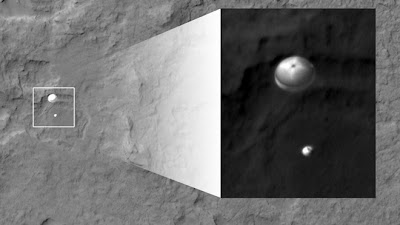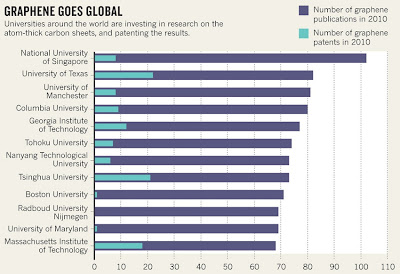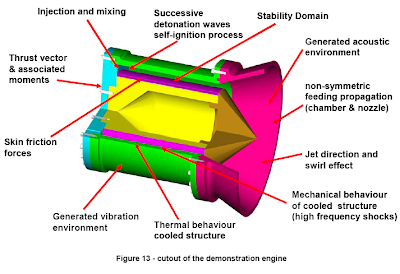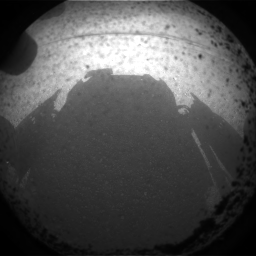Click here to read this mailing online.
|
Carnival of Space 2611. Centauri Dreams asks whether a white dwarf star could sustain planets with life, after reading an intriguing new study that makes the case for an 8-billion year habitable 'window.'
2. Nextbigfuture - The HiRISE camera is onboard the Mars Reconnaissance Orbiter (MRO) photographed the landing of the Mars Science Laboratory which contained the Curiosty Rover. Read more » Global Graphene Research and FundingNature - Britain's big bet on Graphene. Manchester institute will focus on commercial applications of atom-thick carbon sheets.
The UK government is hoping that Novoselov and Geim can make money from graphene. In February, the UK Engineering and Physical Sciences Research Council (EPSRC) announced £50 million (US$78 million) in funding for a National Graphene Institute at the university. Scheduled to open in 2015, the centre will be a hub for translating basic research into industrial applications. Researchers at Manchester will mingle with industrial scientists loaned by domestic and overseas technology firms. Spin-off companies will flourish in off-campus research parks, sparking a technology revolution in a city that was once at the centre of the Industrial Revolution. That’s the vision, at least.
The University of Manchester is a microcosm of a global boom in graphene research (see ‘Graphene goes global’). More than 20 academics from its chemistry, biology, materials science and engineering departments participate in weekly meetings about the material. The discussions are not only about electronics: some colleagues are studying graphene for use in biosensors, and others want to incorporate it into advanced materials Sample of Other Graphene Funding South Korea has approved a roadmap for graphene commercialization with $200 million budget for the next 6 years. They are also looking at a research institute that they would fund with $200-300 million per year. Europe is currently in a pilot project for graphene which could become a 1 billion euro over ten year flagship project. Read more » Curiosity Landing Photographed from HiRISE camera on the Mars Reconnaissance OrbiterA NASA satellite in orbit around Mars was able to capture this picture of the split second when Curiosity fell from the skies to its successful landing on the surface of the red planet.
In the amazing photograph, the rover's parachute is fully deployed and the spacecraft is slowing from the screaming speeds of approach -- as Mars tugged on the spacecraft, it accelerated from 8,000 mph to as much as 13,200 mph -- to a gentle, 2 mph plunkdown on the planet. Read more » Hypersonic Engines - Reaction Sabre and Airbus Continuous Detonation Wave EnginesNew Scientist - Reaction Engines UK is developing the Sabre hydrogen-and-air-burning engine. It is designed to reach orbit in a future satellite-launching spaceplane called Skylon, and may be used suborbitally in a point-to-point Mach 5 passenger aircraft.
These hypersonic planes for commercial aviation would be about 25-40 years away. They could appear earlier for unmanned, space and military purposes. It would be easier (less certification and testing) to make them work for missiles. Missiles are one time use. Next would be hypersonic (but reusable) UAVs. There is also a continuous detonation wave engine (16 pages) that is being developed in a joint venture between MBDA Missile Systems, the aerospace firm EADS, which owns Airbus, and the Lavrentyev Institute of Hydrodynamics in Novosibirsk, Russia. Detonation wave engines, thanks to their more efficient thermodynamic properties, are expected to exhibit a higher level of performance than more conventional propulsion system that rely on constant-pressure combustion processes. Nevertheless, it still has to be proved that this advantage is not superseded by the difficulties which could be encountered to practically define a real engine and to implement it in an operational flying system. In that respect, continuous detonation wave principle appears less challenging than the pulsed detonation process and should lead to the development of more efficient propulsion systems, even if such radical adaptation of the overall engine concept and of the vehicle architecture would be necessary. During past years, MBDA performed some theoretical and experimental works, mainly in cooperation with the Lavrentyev Institute of Hydrodynamics in Novosibirsk. These studies aimed at obtaining a preliminary demonstration of the feasibility of a Continuous Detonation Wave Engine for air-breathing and rocket application. Compared to a Pulsed Detonation Engine,this design allows an easier operation in reduced-pressure environment and an increase in engine mass flow rate and thrust-to weight ratio. Read more » Robotic, Self-Sustaining Architecture to Utilize Resources and Enable Human Expansion Throughout the Solar SystemRobotic, Self-Sustaining Architecture to Utilize Resources and Enable Human Expansion Throughout the Solar System (36 pages)
UPDATE - 24 page preprint copy of the paper. Nextbigfuture looked at the paper before when only the abstract was available. ABSTRACT- Advances in robotics and additive manufacturing have become game‐changing for the prospects of space industry. It has become feasible to bootstrap a self‐sustaining, self‐expanding industry at reasonably low cost. Simple modeling was developed to identify the main parameters of successful bootstrapping. This indicates that bootstrapping can be achieved with as little as 12 metric tons (MT) landed on the Moon during a period of about 20 years. The equipment will be teleoperated and then transitioned to full autonomy so the industry can spread to the asteroid belt and beyond. The strategy begins with a sub‐replicating system and evolves it toward full self‐sustainability (full closure) via an in situ technology spiral. The industry grows exponentially due to the free real estate, energy, and material resources of space. The mass of industrial assets at the end of bootstrapping will be 156 MT with 60 humanoid robots, or as high as 40,000 MT with as many as 100,000 humanoid robots if faster manufacturing is supported by launching a total of 41 MT to the Moon. Within another few decades with no further investment, it can have millions of times the industrial capacity of the United States. Modeling over wide parameter ranges indicates this is reasonable, but further analysis is needed. This industry promises to revolutionize the human condition. Key Ideas • Don't launch it; evolve it • Not a simplistic "self-replicator" -The biosphere and industry are not self-replicators • Use "Appropriate Technology" at each step - It doesn't need to be low mass or high tech - It needs to be easy to make in space • The technologies are already being developed -Simply "spin them in" • The technologies are advancing exponentially Read more » Curiosity has landed . . . safely on MarsCuriosity Lands on Mars
August 5, 2012 10:32 PM Read more » More Recent Articles
|









